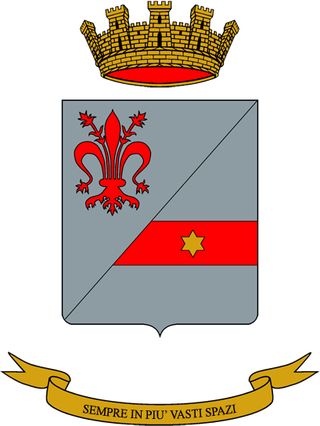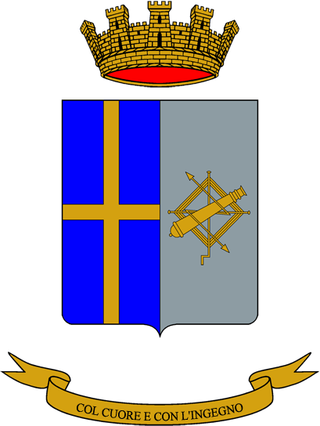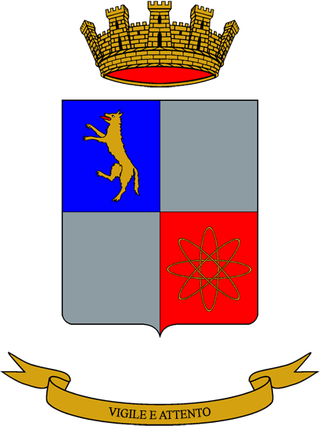
The 2nd Alpine Signal Regiment is an expeditionary signals regiment of the Italian Army based in Bolzano in South Tyrol that specializes in mountain warfare. Since 1951, the unit has been assigned of the 4th Alpine Army Corps and has therefore a strong association with the Italian Army's mountain infantry speciality, the Alpini, with whom the regiment shares the distinctive Cappello Alpino. The unit was first active from 1926 to 1932 as 2nd Radio-Telegraphers Regiment.
The article provides an overview of the entire chain of command and organization of the Italian Army after the reform of 1 May 2024 and includes all active units as of 1 May 2024. The Armed Forces of Italy are under the command of the Italian Supreme Defense Council, presided over by the President of the Italian Republic. The Italian Army is commanded by the Chief of the Army General Staff or "Capo di Stato Maggiore dell’Esercito" in Rome.

Operational Land Forces Command is the Italian Army's major command tasked with the operational and administrative control of most of its combat forces. COMFOTER reports directly to the Chief of Staff of the Italian Army. The command is based in Rome.

The Engineer Command in Rome-Cecchignola commands the specialized engineer regiments of the Italian Army and it is tasked with training of all officers and troops destined for engineer units, as well as with both doctrinal and operational tasks.

The Artillery Command is an Italian Army command, which trains the personnel destined for the army's artillery units, develops the army's artillery doctrine, and supervises the Italian army's artillery units.

The 33rd EW Regiment is an Electronic Warfare unit of the Italian Army based in Treviso. Originally a unit of the army's signal arm, the regiment is today a multi-arms unit assigned to the Tactical Intelligence Brigade, which combines elements of the artillery and signal arms. The unit was formed in 1975 as a battalion and tasked with tactical electronic warfare operations in northeastern Italy. The battalion was named for Falzarego Pass and assigned to the V Territorial Military Command. In 1979, the battalion was transferred to the 5th Army Corps. In 1998, the 8th Signals Intelligence Battalion "Tonale" and 9th Electronic Warfare Battalion "Rombo" were disbanded and part of the two battalions tasks and personnel were transferred to the 33rd Electronic Warfare Battalion "Falzarego". In 2002, the battalion lost its autonomy and entered the newly formed 33rd EW Regiment. The regiment's anniversary falls, as for all signal units, on 20 June 1918, the day the Austro-Hungarian Army began its retreat across the Piave river during the Second Battle of the Piave River.

The 11th Signal Regiment is an expeditionary signals regiment of the Italian Army based in Civitavecchia in Lazio. The unit was formed in 1972 as a battalion and given the number XI, which had been used by two signal battalions during World War II: one of which, had served in the Western Desert campaign and Tunisian campaign; while the other had served during the Allied invasion of Sicily. The reformed battalion was assigned to the Army General Staff's Signal Inspectorate. In 1975, the battalion was named for the Sella di Leonessa Pass and received its own flag. In 1992, the battalion lost its autonomy and entered the newly formed 11th Signal Regiment. In 2001, the regiment reformed the Signal Battalion "Tonale" as its second signal battalion. The regiment is assigned to the army's Signal Command and affiliated with the Army Special Forces Command. The regiment's anniversary falls, as for all signal units, on 20 June 1918, the day the Austro-Hungarian Army began its retreat across the Piave river during the Second Battle of the Piave River.

The 7th Signal Regiment is an expeditionary signals regiment of the Italian Army based in Sacile in Friuli-Venezia Giulia. In 1918, during World War I, the regiment was formed as 7th Engineer Regiment (Telegraphers) with 59 companies transferred from the 3rd Engineer Regiment (Telegraphers). In 1920, the regiment was disbanded and its companies formed into battalions, which were assigned to the Royal Italian Army's army corps.

The 1st Signal Regiment is an expeditionary signals regiment of the Italian Army based in Milan in Lombardy. The unit was formed in 1906 in Rome as a detached brigade of the 3rd Engineer Regiment (Telegraphers) and tasked with training the army's wireless telegraphy personnel. In 1919, the battalion was expanded to Radio-Telegraphers Engineer Regiment, which split in 1926 to form the 1st Radio-Telegraphers Regiment and 2nd Radio-Telegraphers Regiment. Both regiment were disbanded in 1932.

The 46th Signal Regiment is a national support signals regiment of the Italian Army based in Palermo in Sicily and Nocera Inferiore in Campania. The unit was formed as a battalion in 1976 and named for Mount Mongibello. At the time the battalion operated the army's telecommunications network on the island of Sicily. In 1997, the battalion lost its autonomy and entered the newly formed 46th Signal Regiment. In 1998, the 46th Signal Regiment was assigned to the army's Signal Command. On 1 January 2001, the regiment received the Signal Battalion "Vulture" from the disbanded 45th Signal Regiment, which operated the army's telecommunications network in southern Italy. Since then the regiment operates the army's telecommunications network in southern Italy and Sicily. The regiment's anniversary falls, as for all signal units, on 20 June 1918, the day the Austro-Hungarian Army began its retreat across the Piave river during the Second Battle of the Piave River.

The 32nd Signal Regiment is a national support signals regiment of the Italian Army based in Padua in Veneto and Turin in Piedmont. The unit was formed in 1953 as an operational signal battalion and assigned to the Signal Command of the Command Designated "3rd Army". In 1972, the Command Designated "3rd Army" was disbanded and the battalion was assigned to the V Territorial Military Command. In 1975, the battalion was transferred to the 5th Army Corps and named for the Valles Pass. The same year the battalion received its own flag. In 1992, the battalion was reorganized as a national support signal battalion and took over the tasks and personnel of the disbanded 42nd Signal Battalion "Pordoi". The same year the battalion lost its autonomy and entered the newly formed 32nd Signal Regiment. In 1998, the regiment received the Signal Battalion "Frejus" from the disbanded 41st Signal Regiment. Today the regiment is assigned to the army's Signal Command and operates the army's telecommunications network in Northern Italy. The regiment's anniversary falls, as for all signal units, on 20 June 1918, the day the Austro-Hungarian Army began its retreat across the Piave river during the Second Battle of the Piave River.

The 3rd Signal Regiment is a national support signals regiment of the Italian Army based in Rome in Lazio. The regiment is the army's oldest signal regiment and assigned to the army's Signal Command. The regiment's three battalions operate the army's telecommunications network in central Italy and Sardinia. The regiment was formed in 1883 as an engineer regiment, which, in 1895, became responsible for training the Royal Italian Army's telegraph personnel and for providing telegraph units to operational units. In 1912, the regiment added the training of wireless telegraphy personnel to its duties. During World War I the regiment formed a total of 127 companies, 59 of which were transferred in 1918 to the newly formed 7th Engineer Regiment (Telegraphers). In 1920, the regiment was disbanded and its companies formed into battalions, which were assigned to the Royal Italian Army's army corps.

The 8th Signals Intelligence Battalion "Tonale" is a former signals intelligence (SIGINT) and currently signals battalion of the Italian Army. The battalion was formed in 1976 and named for the Tonale Pass. The battalion was the army's strategic signals intelligence unit during the Cold War. In 1998, he battalion was disbanded and its tasks and personnel transferred to the Italian Army's 33rd Electronic Warfare Battalion "Falzarego" and the Italian Armed Forces' Information and Security Department. In 2001, the battalion was reformed and assigned to the 11th Signal Regiment as the regiment's second signal battalion. The battalion's anniversary falls, as for all signal units, on 20 June 1918, the day the Austro-Hungarian Army began its retreat across the Piave river during the Second Battle of the Piave River.

The Operational Land Forces Support Command is a major subdivision of the Italian Army tasked with providing support resources to the Operational Land Forces Command.

The 9th Cybernetic Security Regiment "Rombo" is a cyber warfare unit of the Italian Army based in Cecchignola in Rome. The regiment is part of the Signal Arm and assigned to the Tactical Intelligence Brigade. The regiment is tasked with performing cyber operations related to the defence of the Italian Army's IT networks and Command-and-Control systems, and with the protection of critical infrastructures, platforms and weapon systems.

The 41st Signal Regiment is an signals regiment of the Italian Army. The unit was formed as a battalion in 1953 and operated the army's telecommunications network in the Aosta, Liguria, Lombardy, and Piedmont regions. In 1975, the battalion was named for the Col du Fréjus and received its own flag. In 1993, the battalion lost its autonomy and entered the newly formed 41st Signal Regiment. In 1998, the 41st Signal Regiment was disbanded and the Signal Battalion "Frejus" transferred to the 32nd Signal Regiment. The regiment's anniversary falls, as for all signal units, on 20 June 1918, the day the Austro-Hungarian Army began its retreat across the Piave river during the Second Battle of the Piave River.

The 43rd Signal Regiment is an signals regiment of the Italian Army. The unit was formed as a battalion in 1957 and operated the army's telecommunications network in the Tuscany and Emilia-Romagna regions. In 1975, the battalion was named for the Abetone Pass and received its own flag. In 1993, the battalion lost its autonomy and entered the newly formed 43rd Signal Regiment. In 1998, the 43rd Signal Regiment was disbanded and the Signal Battalion "Abetone" transferred to the 3rd Signal Regiment, which operates the army's telecommunicationss network in central Italy and on the island of Sardinia. The regiment's anniversary falls, as for all signal units, on 20 June 1918, the day the Austro-Hungarian Army began its retreat across the Piave river during the Second Battle of the Piave River.

The 45th Signal Regiment is an signals regiment of the Italian Army. The unit was formed as a battalion in 1957 and operated the army's telecommunications network in the Apulia, Basilicata, Calabria, Campania and Molise regions. In 1975, the battalion was named for Monte Vulture and received its own flag. In 1993, the battalion lost its autonomy and entered the newly formed 45th Signal Regiment. In 2001, the 45th Signal Regiment was disbanded and the Signal Battalion "Vulture" transferred to the 46th Signal Regiment. The regiment's anniversary falls, as for all signal units, on 20 June 1918, the day the Austro-Hungarian Army began its retreat across the Piave river during the Second Battle of the Piave River.

The 47th Signal Battalion "Gennargentu" is a signals battalion of the Italian Army. The battalion operates the army's communications network on the island of Sardinia. During the 1990s, the battalion was an autonomous unit, but in 2000 the battalion lost its autonomy and entered the 3rd Signal Regiment as Signal Battalion "Gennargentu". The battalion is based in Cagliari. The battalion's anniversary falls, as for all signal units, on 20 June 1918, the day the Austro-Hungarian Army began its retreat across the Piave river during the Second Battle of the Piave River.

The 42nd Signal Battalion "Pordoi" is a signals battalion of the Italian Army. The battalion was formed in 1953 and operated the army's telecommunications network in the Friuli-Venezia Giulia, Trentino-Südtirol, and Veneto regions. In 1975, the battalion was named for the Pordoi Pass and received its own flag. In 1993, the battalion was disbanded and its personnel and tasks transferred to the 32nd Signal Regiment. In 2001, the battalion was reformed and assigned to the 2nd Alpine Signal Regiment as the regiment's second signal battalion. The battalion's anniversary falls, as for all signal units, on 20 June 1918, the day the Austro-Hungarian Army began its retreat across the Piave river during the Second Battle of the Piave River.



















